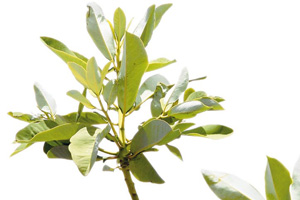Chile is considered a biogeographical island because its territory spans between a vast ocean and the Andes mountain range. In addition, it has a great diversity of ecosystems (forests, desert, high plateau, etc.) and climates. However, compared to other South American countries (like Peru and Brazil), native flora is scarce, it only has 5,739 species, but presents a high degree of endemism (species that belong only here and are exclusive), which reaches 2,630 species, meaning, around 46% out of the total species.
The flora is mainly concentrated in the central south zone, which spans from the region of Coquimbo to the region of los Lagos. North and south of this area, the abundance and richness of species goes down as the climate gets drier, more humid or cold.
The Great and Lesser North is characterized by its arid climate which gives way to a landscape with scarce vegetation. Among the most characteristic species are the Prosopis tamarugo (Prosopis tamarugo), a tree capable of developing thanks to the water from the phreatic aquifers (a layer of underground water that is closest to the ground). The Dalea azurea is also found here, as well as the Oxalis gigantean, the Puya boliviensis and the Roman Cassie (Acacia caven), among others.
In the central and southern part of the country, flora is more abundant because it is favored by a Mediterranean climate (four clearly marked seasons with a dry summer and a cold, rainy winter). The sclerophyll forest extends in this area, where species like the Boldo (Peumus boldus), the Litre (Lithraea caustica), the Soap Bark Tree (Quillaja saponaria), the Chilean Myrtle (Luma apiculata) and the Nothofagus oblicua (Nothofagus oblicua). South of the Biobio river, the so-called Valdivian forest presents itself, where the Chilean Guava (Ugni molinae), the Chilean Bellflower (Lapageria rosea), the Chilean Laurel (Laurelia sempervirens), the Chilean hazle (Gevuina avellana), the Monkey-Puzzle (Araucaria araucana) and the Patagonian Cypress (Fitzroya cupressoides) all grow.
In the two southernmost regions of the country (Aysen and Magallanes), there are great extensions of evergreen forest, although with less arborous species, especially noteworthy are the Pilgerodendron (Pilgerodendron uviferum), the Lenga Beech (Nothofagus pumilio), the Winter’s Bark (Drimys winteri), the Magellan’s Beech (Nothofagus betuloides) and the Antarctic Beech (Nothofagus antarctica).
The plant diversity of the Antarctic territory, as it is almost completely covered by permanent ice, is reduced to a few species of moss and lichen, although there are small plants with flowers, like the Antarctic Pearlwort (Colobanthus quitensis).
It is worth pointing out that the non-profit organization Conservation International, created in 1987, identified Chile as one of the 34 most important priority areas of biodiversity or hotspots in the world. These areas are those that contain at least 1,500 species of endemic plants and have lost at least 70% of their original habitat. Eleven of the twelve types of recognized forest grow in these priority biodiversity areas. The Chilean Wine Palm (Jubaea chilensis) is within one of the world’s southernmost palm forests, while the Roble-Hualo forests of the Coastal and Andes mountain range contain important endemic species, like the Olivillo (Aextoxicon punctatum), the Keule (Gomortega keule), the Ruil (Nothofagus alessandrii), the Hualo (Nothofagus glauca), the Legrandia concinna and the Pitavia punctata.
In addition, the temperate rainforests of the south, like the Argentinean ones, are the only ones in South America that contain the Monkey_Puzzle (Araucaria araucana), which can live up to 1,500 years, and the Patagonian Cypress (Fitzroya cupressoides), one of the largest trees (it reaches a height of over 50 meters) found in the southern hemisphere.








 Muere Evita
Muere Evita